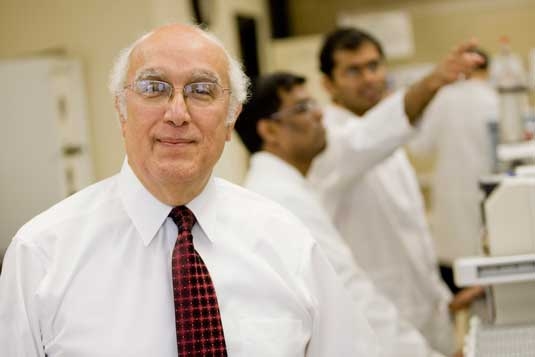With Moulder expansion, Temple will create region’s first integrated drug discovery center
Responding to a trend in which pharmaceutical companies are increasingly seeking partnerships with small biotech companies and academic institutions, Temple is creating the Greater Philadelphia region’s only fully integrated center for researching and developing new drugs.
The initiative will expand and enhance the Moulder Center for Drug Discovery Research in Temple’s School of Pharmacy to allow for greater collaboration with local, national and international biotech companies as well as with researchers in Temple’s School of Medicine, College of Science and Technology and College of Engineering.
“The pharma industry is going through some really unprecedented challenges,” said Magid Abou- Gharbia, director of the Moulder Center and associate dean for research in Temple’s School of Pharmacy. “Pharma does not have a sufficient number of new products coming to market from the pipeline to overcome the high drug failure rate. So the industry is seeking to close this innovation gap by collaborating with academic institutions like Temple and small biotech companies to enrich their product pipeline.”
The Moulder Center for Drug Discovery Research was established in Temple’s School of Pharmacy in 2008 through a gift by alumni Lonnie and Sharon Moulder (Pharm ’80). Abou-Gharbia, an internationally recognized leader in drug discovery who spent 26 years at Wyeth Pharmaceuticals and holds more than 350 worldwide patents, was recruited to head the new center.
The center has received funding from the National Institutes of Health for specific drug discovery projects; now through substantial funding from the university the center is expanding and enhancing its facilities and resources to conduct fully integrated drug discovery.
According to Abou-Gharbia, the center is adding state-of-the-art medicinal chemistry and screening laboratories; purchasing a 20,000-compound library that will allow for better drug screening and optimization; and implementing a computer-aided drug design system for virtual drug screening. The center also will add more staff, including a tenure-track associate professor who will begin this fall. Additionally, the School of Pharmacy will hire two new faculty members who will contribute to the initiative.
“The medicinal chemistry expertise provided by the Moulder Center through this new initiative will make it possible for interdisciplinary teams of Temple researchers to synergistically pursue the development of new potential therapeutic entities,” said School of Pharmacy Dean Peter Doukas. “These teams can form based on a willful coalescence of expertise from various laboratories within or outside the university.”
Abou-Gharbia said that the initiative expands the work of the Moulder Center from School of Pharmacy-centric to university wide, making it a valuable resource for School of Medicine, College of Science and Technology and College of Engineering researchers doing work on different biological targets, such as proteins and enzymes associated with various diseases.
“We can now give them the tools and chemical probes to modulate those biological targets and then take the next step by turning them into true drug candidates,” he said.
He said that the Philadelphia region’s historically high concentration of pharmaceutical companies has made it the “Silicon Valley” of biomedical research and drug discovery. But despite that historic significance, said Abou-Gharbia, the region has not had a fully integrated academic center focused solely on drug discovery.
“Various centers and institutions currently carry out certain aspects of drug discovery research,” he said. “This initiative by Temple makes the Moulder Center the only fully integrated center for drug discovery in the tri-state area.”
